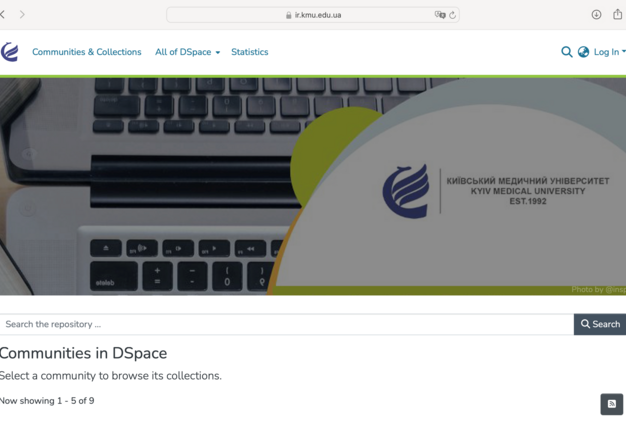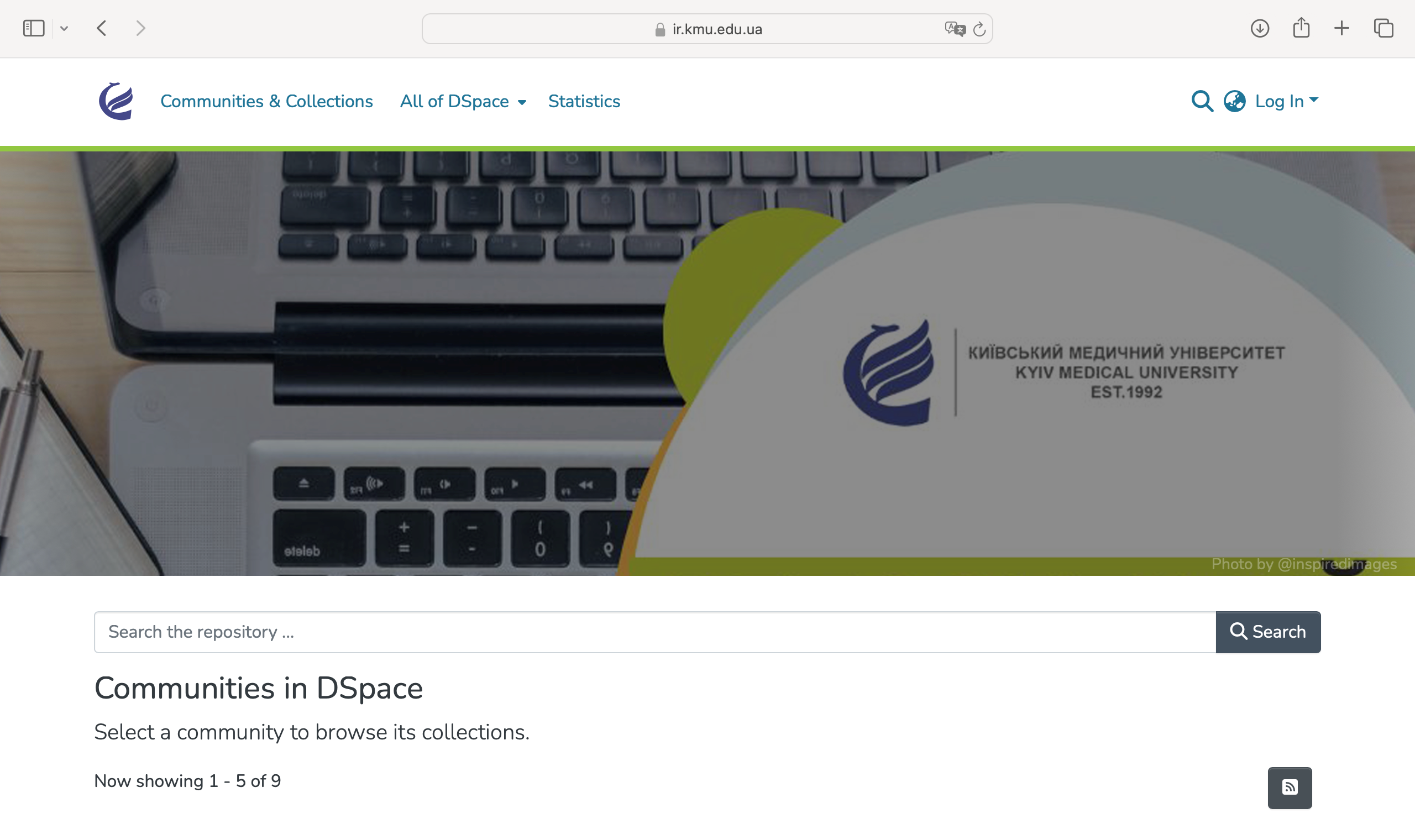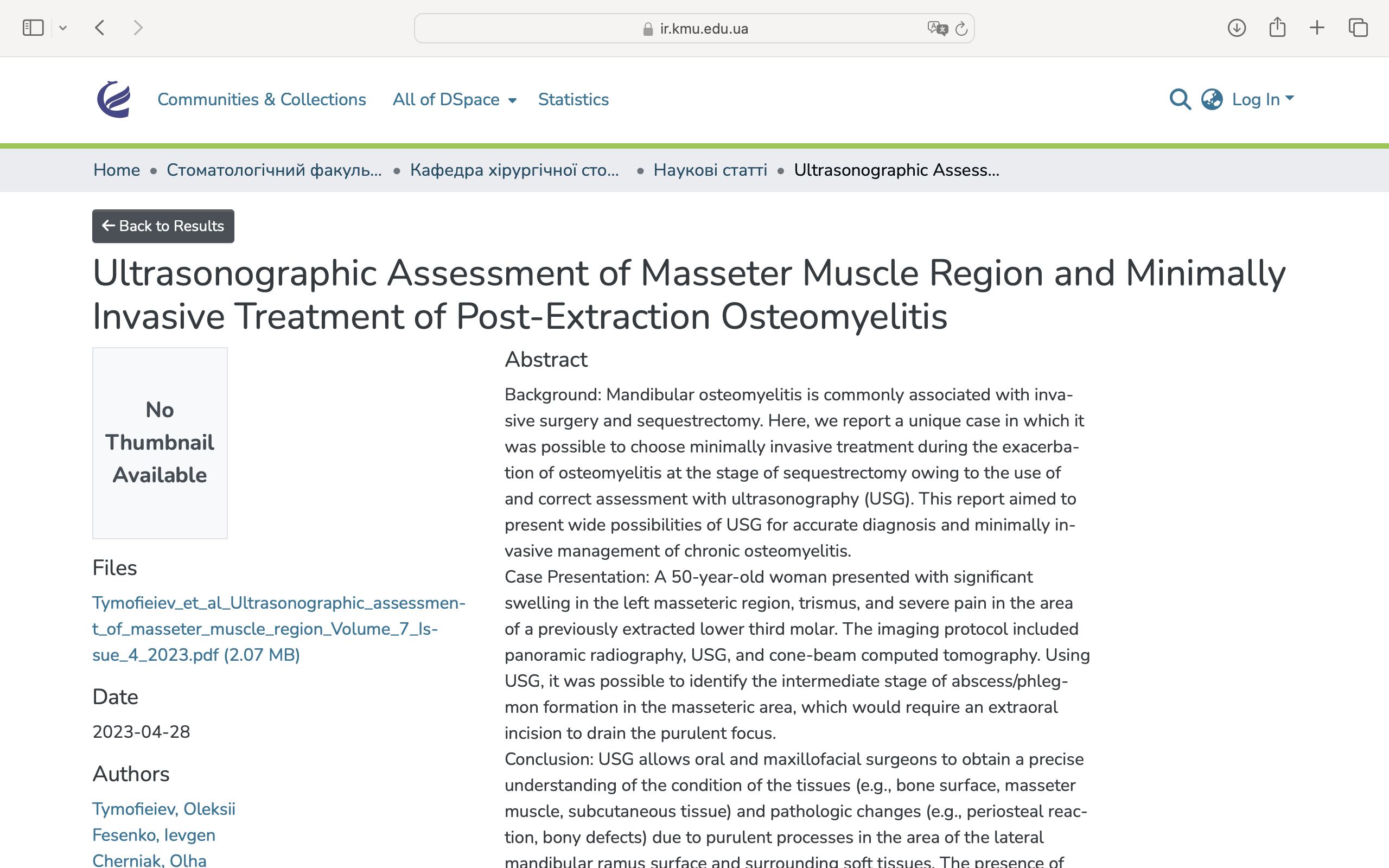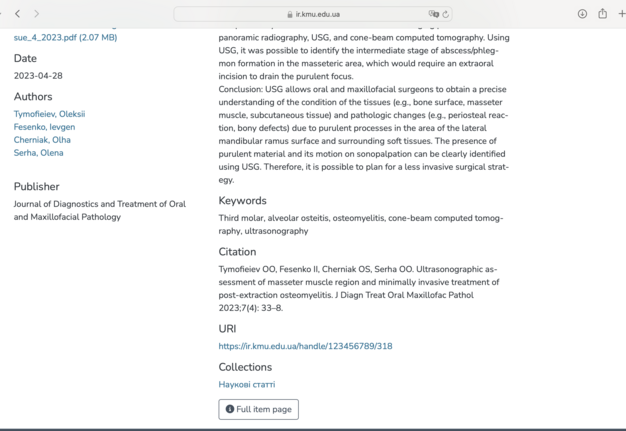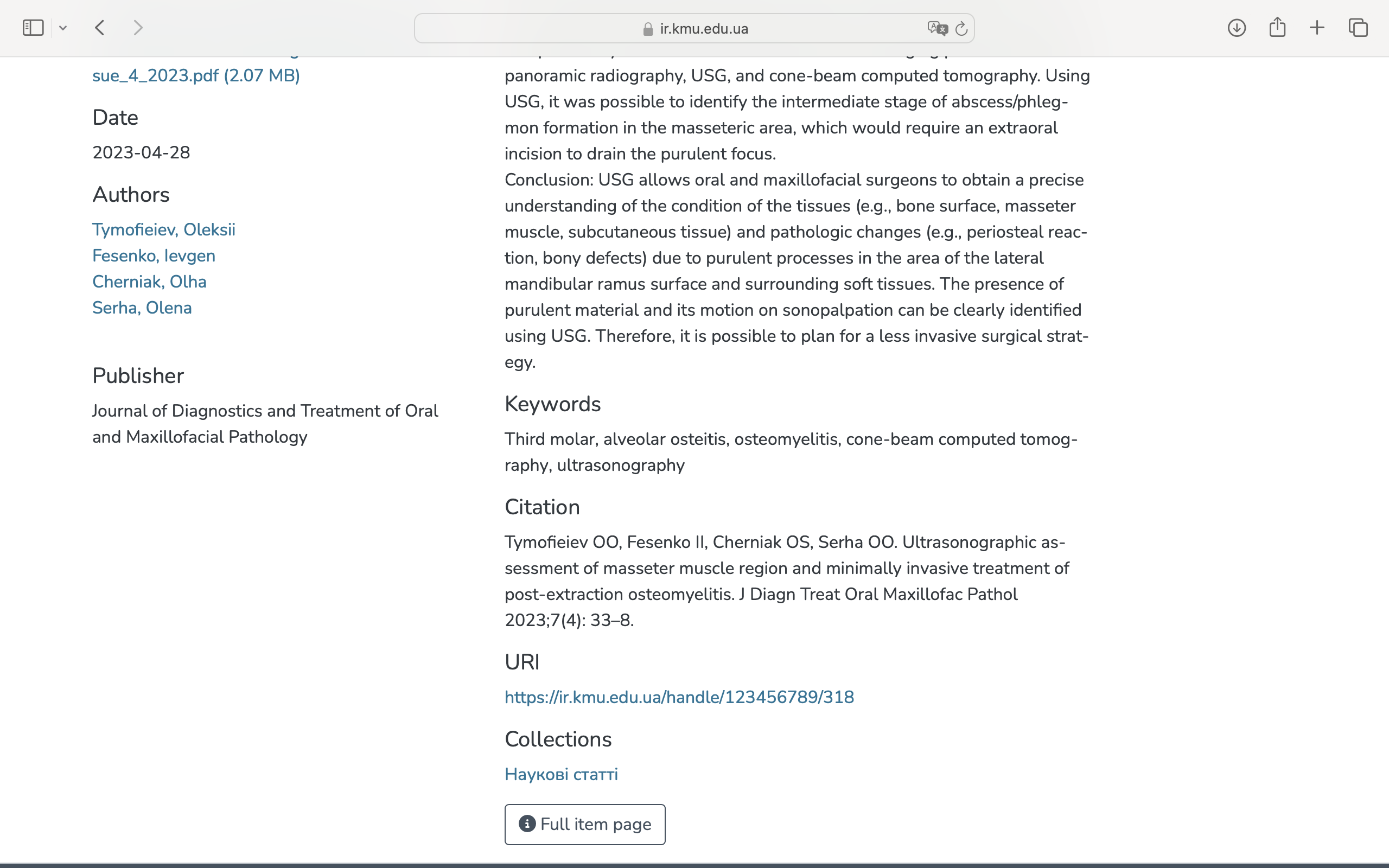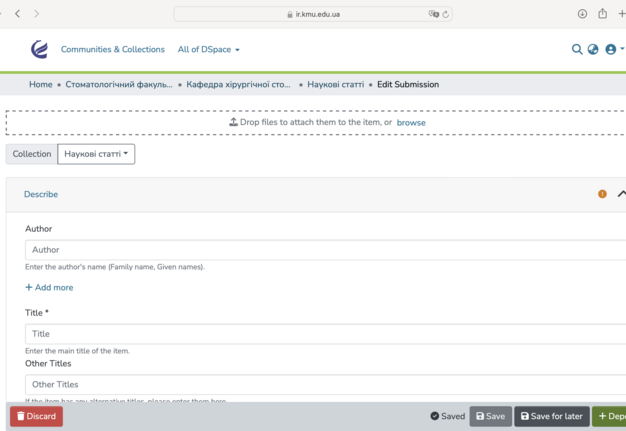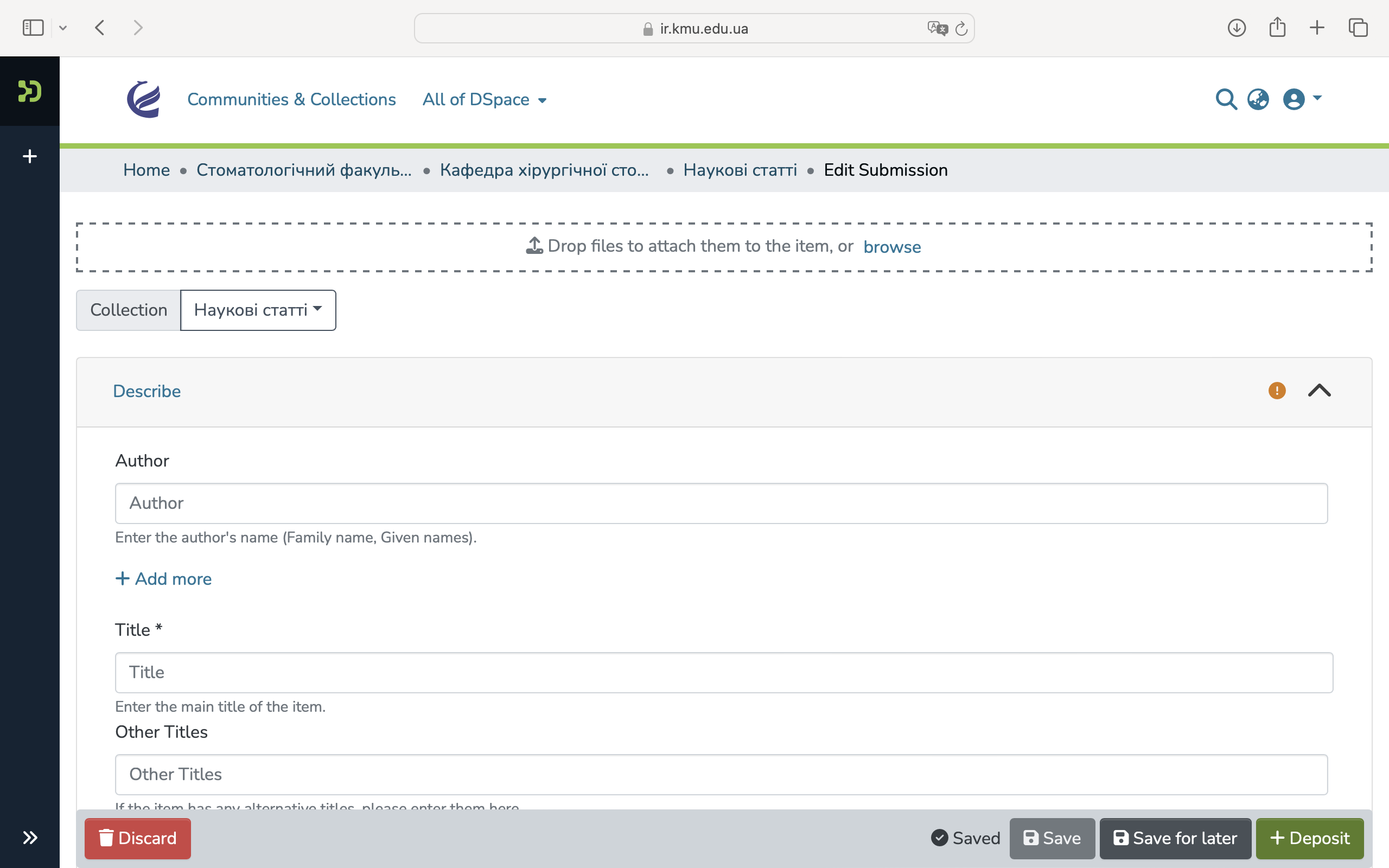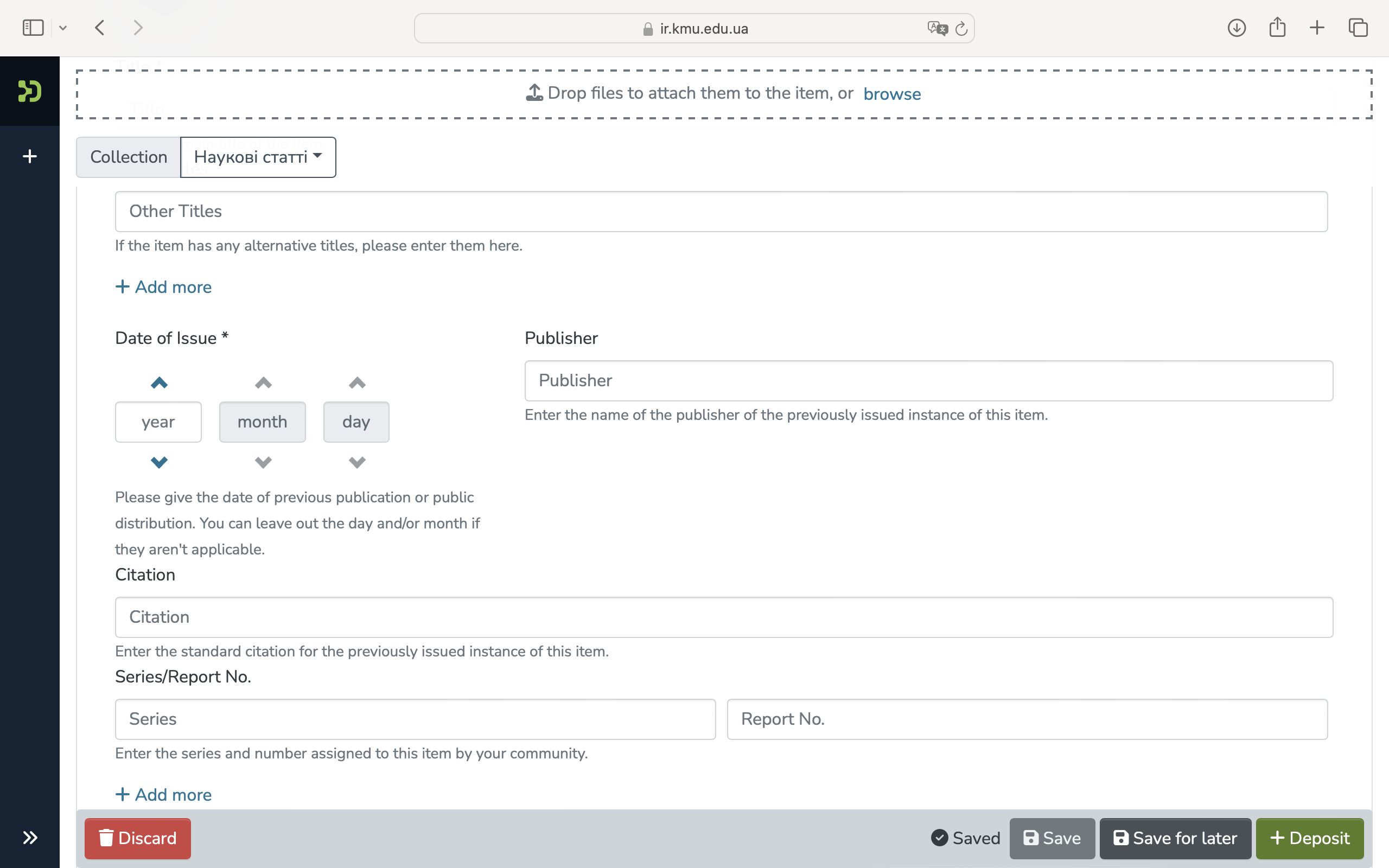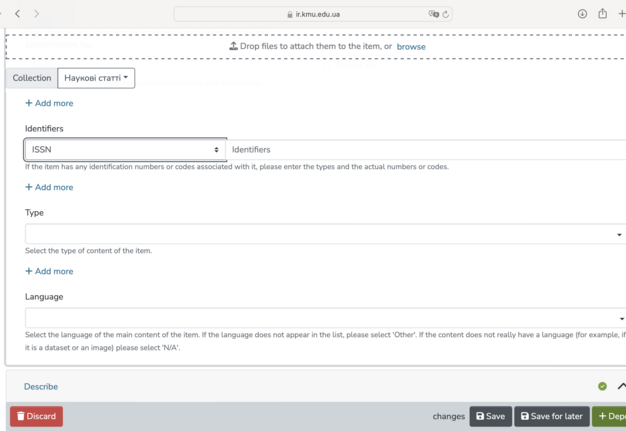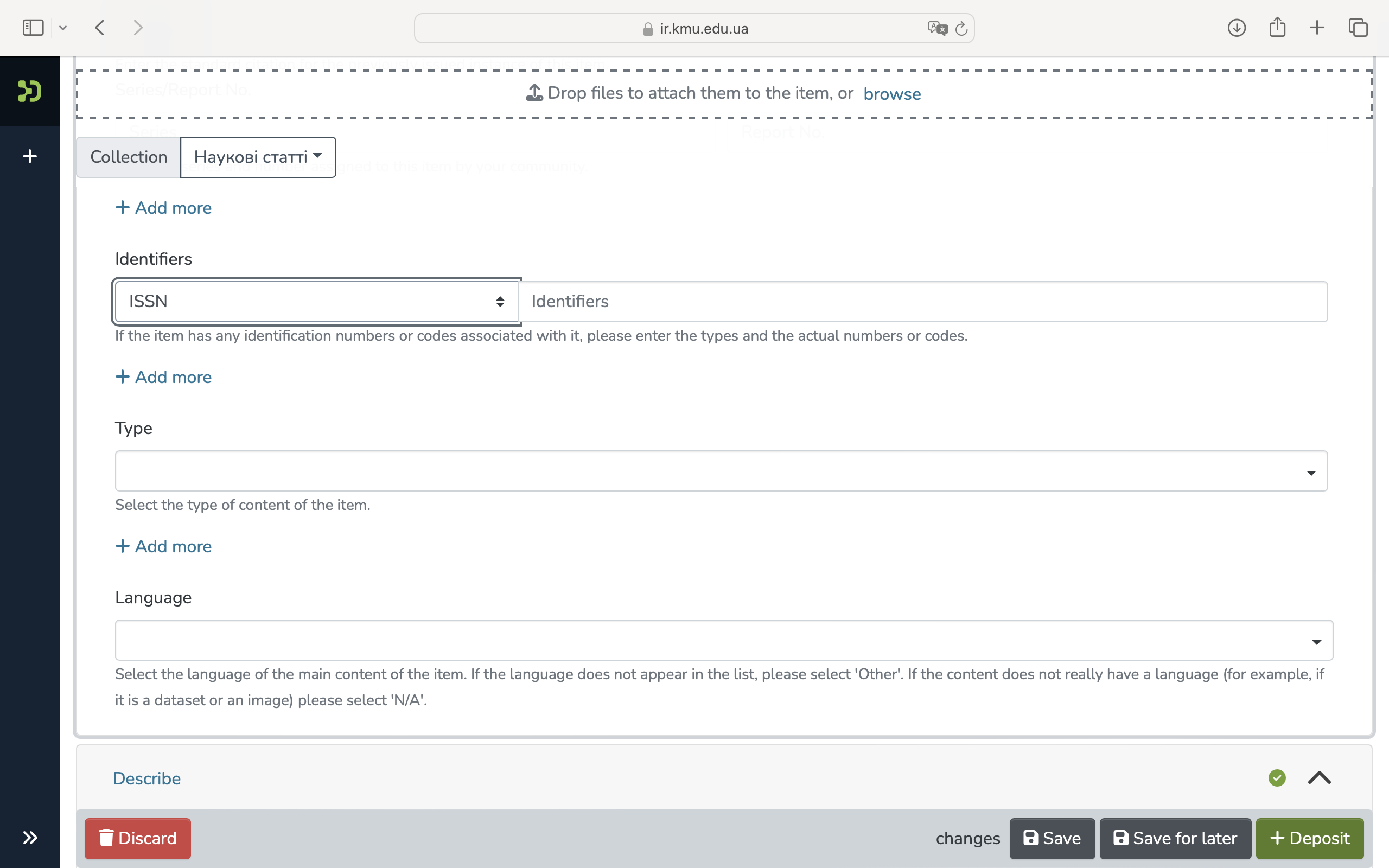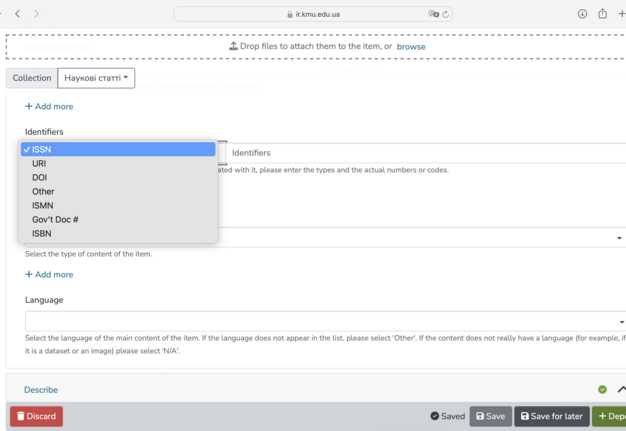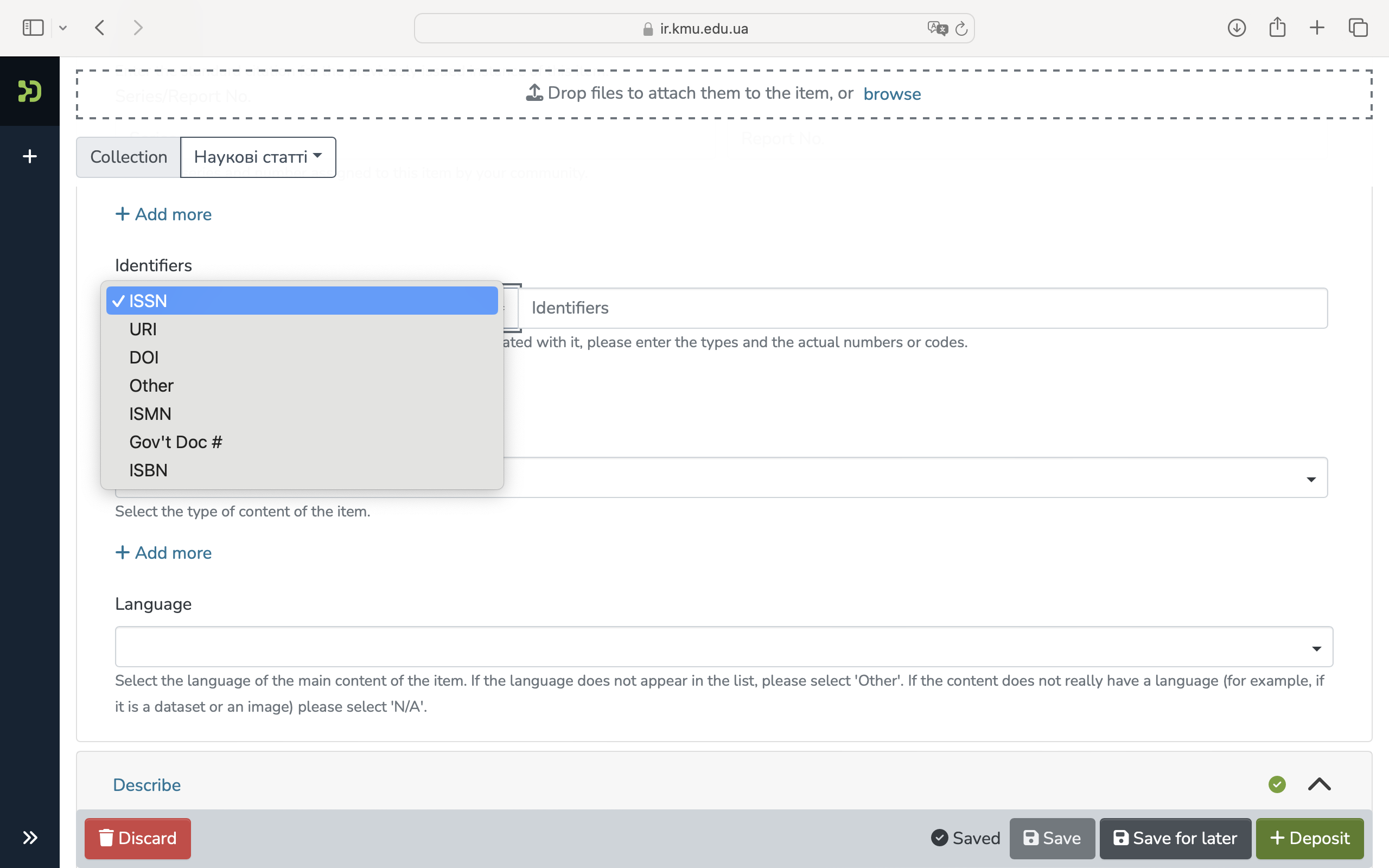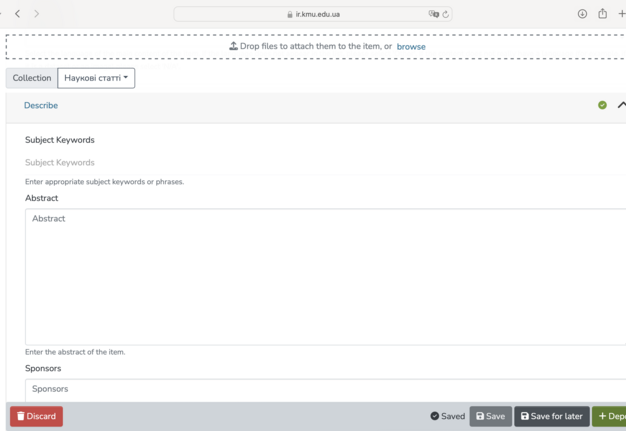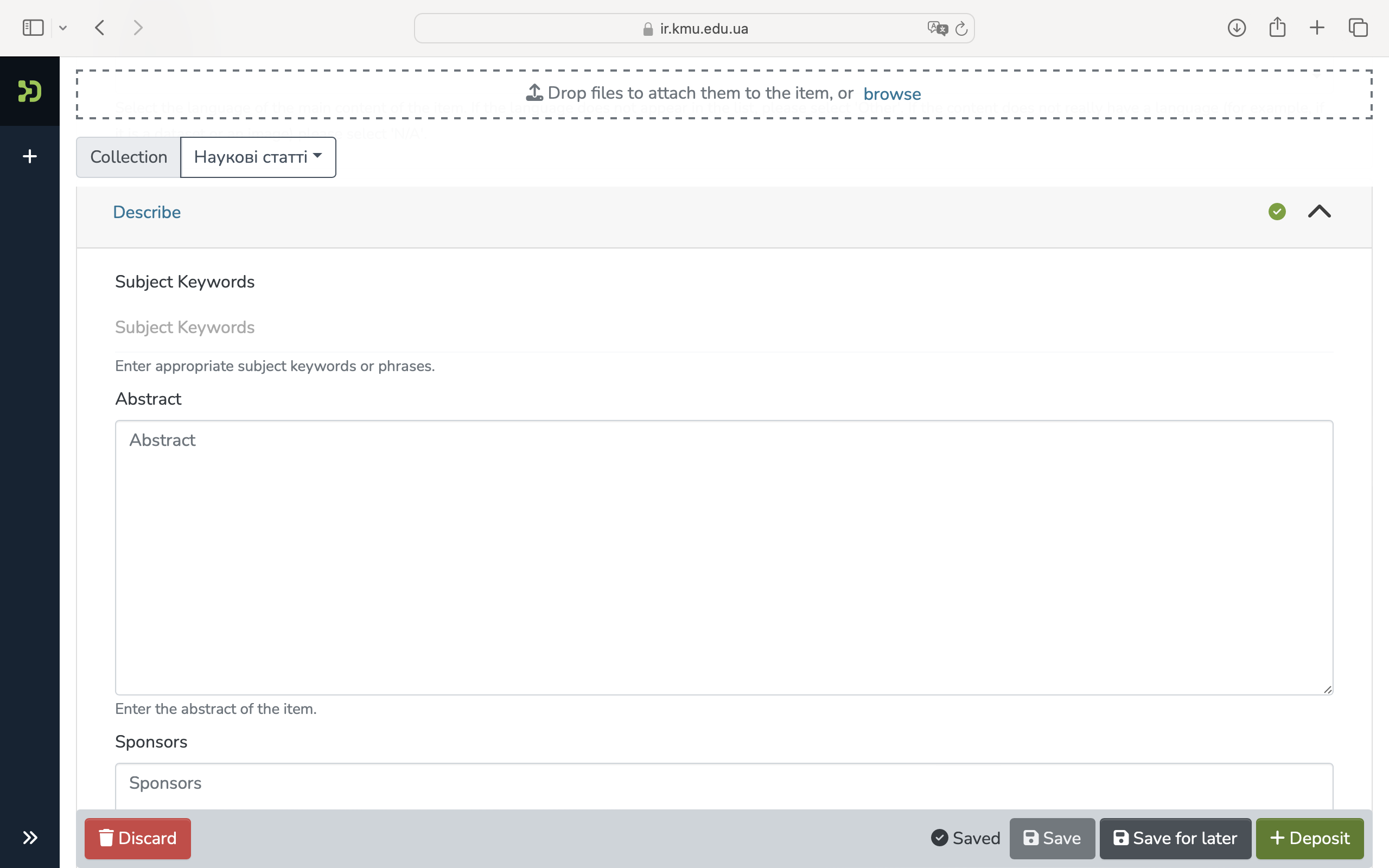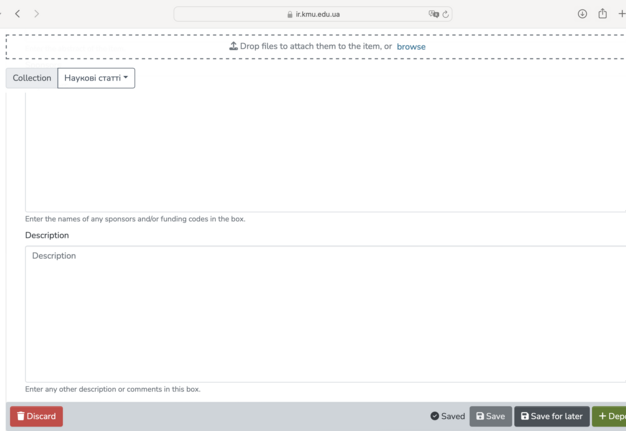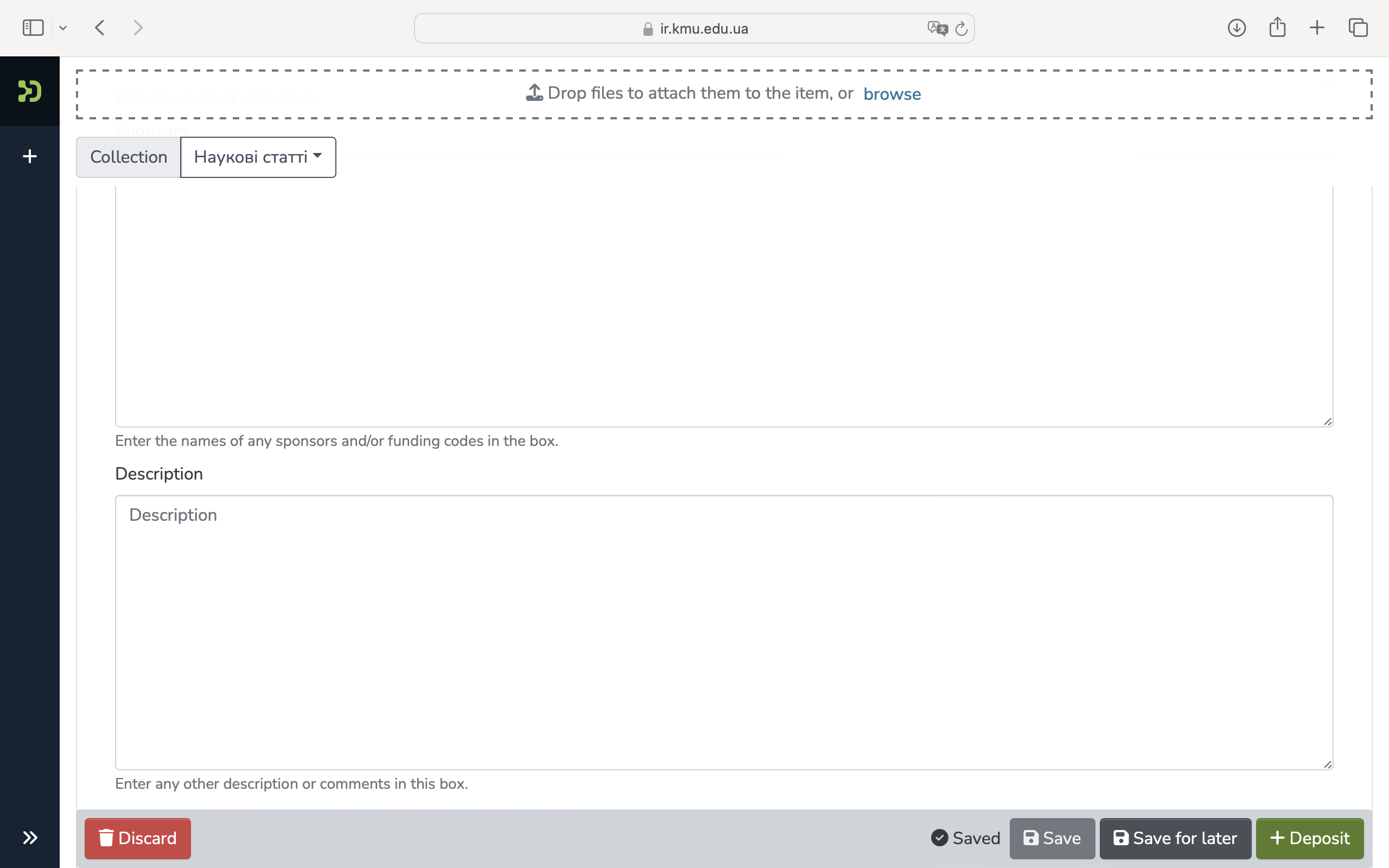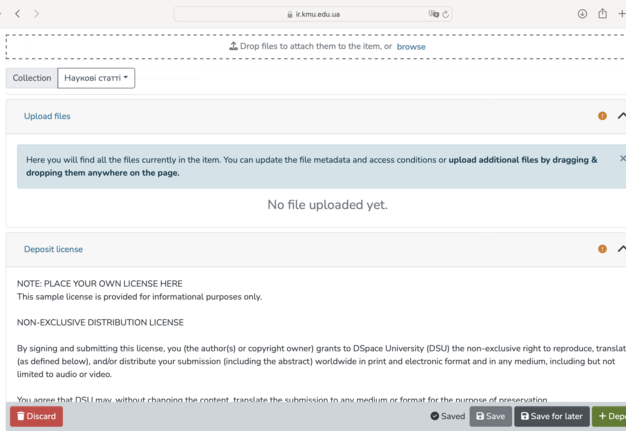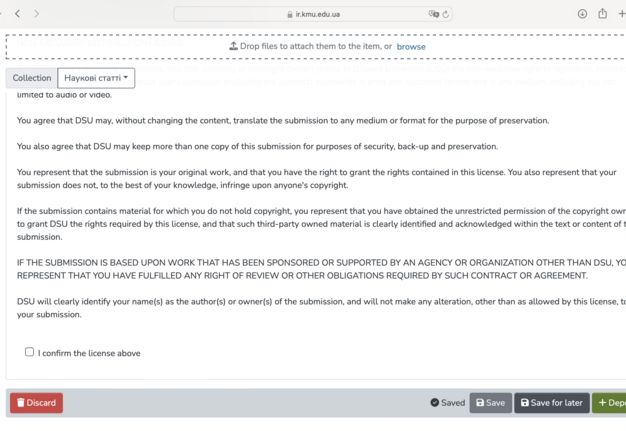Editorial: Institutional Repository of the Kyiv Medical University: A New Open Access Database for Authors and Peer-Reviewed Journals
December 21, 2024
J Diagn Treat Oral Maxillofac Pathol 2024;8: 100300.
DOI: 10.23999/j.dtomp.2024.12.100300
Under a Creative Commons license
HOW TO CITE THIS ARTICLE
Tymofieiev OO, Fesenko II, Serha OO. Editorial: Institutional repository of the Kyiv Medical University: A new open access database for authors and peer-reviewed journals. J Diagn Treat Oral Maxillofac Pathol. 2024 Dec;8(12):100300. https://doi.org/10.23999/j.dtomp.2024.12.100300
NATIONAL REPOSITORY OF ACADEMIC TEXTS
https://nrat.ukrintei.ua/en/searchdoc/2024U000191/
INSTITUTIONAL REPOSITORY
https://ir.kmu.edu.ua/handle/123456789/791
ABSTRACT
Open access repository is a database, or a virtual archive established to collect, disseminate and preserve scientific output like scientific articles and datasets and to make them freely available. An institutional repository is one of four types of repositories. The purposes of this article are (1) to highlight the most important points of the Regulation on the Institutional Repository of the Kyiv Medical University (IRKMU) and (2) to explain the advantages for authors and peer-reviewed journals of colonization of the repository of such type. Also, this paper highlights the experience of the Department of Oral and Maxillofacial Surgery and the Journal of Diagnostics and Treatment of Oral and Maxillofacial Pathology (JDTOMP) in depositing peer-reviewed articles in this repository. The Regulation on the IRKMU was put into effect by Order No. 29 of January 26, 2024. In the same year, all structural units of the university, including dental departments, joined the process of depositing their scientific and clinical works. The IRKMU was created using the open-source software DSpace, which supports the Open Access Initiative Protocol for Metadata Harvesting (OAI-PMH) data exchange protocol, allowing the repository to be integrated into the international registers of the Registry of Open Access Repositories (ROAR), Directory of Open Access Repositories (OpenDOAR), and other search engines. The article is reinforced with screenshots of the stages of depositing data of scientific works. Carlile Butterfield and colleagues (2022) emphasized, that despite all benefits, however, their research indicates that it can be difficult to encourage all faculties to upload the research reports onto the institutional repository. Moreover, the authors propose a potential route to maximize the number of publications that are uploaded to a university institutional repository. They utilize student workers and the resources of the institutional repository manager to get materials uploaded. The experience of our department consists in attracting a competent editor from the editorial staff of the JDTOMP with appropriate payment for services. In sum, colonizing this new institutional repository as a new database, authors and peer-reviewed journals can and will increase the visibility of their publications. Thus, it can bear fruit in terms of increasing the citation of articles and the journals as well.
KEY WORDS
Open access, institutional repository, university, database, article, publication
EDITORIAL
A library is a growing organism [1].
Jones et al (2006)
Repository is a location, either real or virtual, where data is stored [2]. The Latin word "reponere" means "to put back" [3]. An open access repository is a database, or a virtual archive established to collect, disseminate and preserve scientific output like scientific articles and datasets and to make them freely available [4].
Repositories can be either linked to an institution or department or linked to a research field or subject, i.e. (1) institutional or (2) subject repositories [4]. In other sources, the following types of repositories are distinguished: content repository, discipline repository, information repository, and institutional repository [2].
Authors emphasized that a repository is a broad term that can be used to describe various ways to collect and store data [2]. The institutional repository refers to database, i.e. a collection of information organized in such a way that a computer program can quickly select desired pieces of data [2].
The Kyiv Medical University is a Private Higher Educational Establishment [5] that has been continuously implementing the most modern educational and scientific technologies since its foundation, namely since 1992. An open access repository became one of them. Institutional Repository of the Kyiv Medical University (IRKMU) (Fig 1) was officially launched in 2024 [6]. The Regulation on the IRKMU was put into effect by Order No. 29 of January 26, 2024 [6].
FIGURE 1. Screenshot of the home page of the Institutional Repository of the Kyiv Medical University (IRKMU). Link: https://ir.kmu.edu.ua.
Below are the official data of the repository according to the Regulation [6]:
-
Official name of the repository in English according to the Regulation: Institutional Repository Kyiv Medical University.
-
Official name of the repository in Ukrainian according to the Regulation: Інституційний репозитарій Київського медичного університету.
-
Abbreviated name in English: IrKMU.
-
The address of the Repository in the global Internet network: www.ir.kmu.edu.ua.
The IRKMU is formed and functions in accordance with the Law of Ukraine "On Education," the Law of Ukraine "On Higher Education," the Law of Ukraine "On Libraries and Library Affairs," the Law of Ukraine "On Copyright and Related Rights," the Law of Ukraine "On the National Informatization Program," the Law of Ukraine "On Electronic Documents and Electronic Document Management," the Law of Ukraine "On Protection of Information in Automated Systems," Regulations on the National Repository of Academic Texts, approved by Resolution No. 541 of the Cabinet of Ministers of Ukraine dated July 19, 2017 [7], and other acts of legislation, the Statute of the University and other internal documents of the University [6].
In March 2000, Hewlett-Packard (HP) Company awarded $1.8 million to the Massachusetts Institute of Technology (MIT) Libraries for an 18-month collaboration to build DSpace™, a dynamic repository for the intellectual output in digital formats of multi-disciplinary research organizations [8]. HP Labs and MIT Libraries released the system worldwide on November 4, 2002 [8]. The IRKMU was created based on the open-source software DSpace, which supports the Open Access Initiative Protocol for Metadata Harvesting (OAI-PMH) data exchange protocol, allowing the repository to be integrated into the international registers of the Registry of Open Access Repositories (ROAR), Directory of Open Access Repositories (OpenDOAR), and other search engines [6].
DSpace is typically used for creating open access repositories for scholarly and/or published digital content [9]. DSpace describes semfelves as “an open source software platform developed and supported by our user community, with the help and support of Lyrasis [10]”. Lyrasis is a non-profit member organization serving and supporting libraries, archives, museums, and cultural heritage organizations around the world [11]. Lyrasis is based in the Atlanta, Georgia, United States [11].
According to Regulation, the purpose (mission) of the IRKMU is to promote the development of medical and related sciences and education in Ukraine and the world by creating, accumulating, systematizing, storing and preserving in electronic form, as well as providing open access via the Internet to the intellectual products of the university community to the Ukrainian and world scientific educational society [6].
The main tasks of the IRKMU according to Regulation are [6]:
-
Creation of organizational, technical and informational infrastructure for centralized and long-term electronic storage of scientific, educational, methodical and journalistic materials of the University, as well as their distribution on the Internet in open access.
-
Increasing the reputation of the University.
-
Promotion of the University's place in the rankings of educational institutions.
-
Promoting the increase of scientometric indicators of the University and its employees.
-
Creation of a reliable and accessible accounting system and distribution of educational and scientific works of University employees.
When placing materials (in particular, articles) in the Repository, the following metadata fields must be filled in according to the Dublin Core scheme [6]:
-
Authors - surname and initials in the original language and in English (if the original article is presented in another language).
-
The title of the work is in the original language and in other languages, if known.
-
Abstract - in the original language (mandatory), in English (preferably).
-
Key words - in Ukrainian and English.
-
Bibliographic description - for previously published materials.
According to the official document of the KMU, the Repository is an online archive of documents in electronic form [6]. The Repository may contain documents created in whole or in part by participants in the educational process and employees of the University, or by third parties at the request of the University or its affiliates [6].
The storage period of documents in the Repository is not limited. Documents in the Repository are stored using the best global practices of data management and digital preservation. Importantly, the University ensures regular backups of the Repository files.
If necessary, an updated version of the document can be placed in the Repository [6]. At the same time, its previous version can be removed from public access with or without linking the appropriate identifier (uniform resource locator [URL]) to the latest version of the document [6].
It is important to know that by decision of the Vice President of the University, the University may remove from the Repository the materials that have signs of plagiarism, contradict the legislation, national interests of Ukraine, contain signs of falsification, or have a low scientific or educational level [6].
It is important to note that KMU is not the only medical higher education establishment in Ukraine in which the Institutional Repository was launched using the DSpace open-source software. Poltava State Medical University also started one using this technological tool [12].
Figure 2 demonstrates screenshots of one of the articles of the department's employees deposited in the IRKMU. Each article after being entered in the Repository receives a unique link. For example, https://ir.kmu.edu.ua/handle/123456789/318 [13, 14]. Each department should also receive a link to the entire selection of scientific works of this department. We add a sample link to the Department's page in the repository: https://ir.kmu.edu.ua/handle/123456789/72 [15].
FIGURE 2A. Screenshots of one of the articles of the department's employees deposited in the IRKMU (A, B). Link: https://ir.kmu.edu.ua/handle/123456789/318.
FIGURE 2B. Screenshots of one of the articles of the department's employees deposited in the IRKMU (A, B). Link: https://ir.kmu.edu.ua/handle/123456789/318.
Screenshots when adding a new article to the repository clearly demonstrate (Fig 3) the importance of each article having an Abstract/Summary [16]. Even if it is the editorial, images, book review, article review or other short articles [16].
Kyiv Medical University is one of the co-founders of the Journal of Diagnostics and Treatment of Oral and Maxillofacial Pathology (JDTOMP) [17]. As members of the editorial team of this JDTOMPfrom one hand, and as a department’s employee from another, we are more than interested in the greater visibility of each of the published articles and in the growth of their citations. Journal colonization of each of the databases is a key element of every journal growth [18]. Therefore, our teams with passion and great inspiration approached the possibility of wider popularization of scientific and clinical results. In fact, the more journals’ employees of the department publish in, the more different journals begin to enter the repository due to article infiltration [19-21]. Sharing our experience of depositing articles in this repository, we are forced to admit that the filling is quite simple, and it can take up to 12 minutes to deposit one article on average.
Carlile Butterfield and colleagues (2022) emphasized, that despite all benefits, however, the research indicates that it can be difficult to encourage all faculties to upload their research onto the institutional repository [22]. Moreover, the authors propose a potential route to maximize the number of publications that are uploaded to a university institutional repository [22]. They utilize student workers and the resources of the institutional repository manager to get materials uploaded [22]. The experience of our department consists in attracting a competent editor from the editorial staff of the JDTOMP with appropriate payment for services.
The fact that only the works of university employees can be deposited is limiting the possibilities of peer-reviewed journals in which these employees have not yet been published. This is one of the limitations of this type of institutional repositories.
In conclusion, it is worth noting that by colonizing the new institutional repository as a new database, authors and peer-reviewed journals can and will increase the visibility of their publications. Thus, it can bear fruit in terms of increasing the citation of both articles and journals as well. University libraries are evolving [23]. And the emergence of university repositories is also one of the manifestations of such evolution. Interestingly, along with the evolution of universities, there is also an interrelated evolution of peer-reviewed journals.
ORCID
Oleksii Tymofieiev, https://orcid.org/0000-0002-3191-6025
Ievgen Fesenko, https://orcid.org/0000-0002-8901-1632
Olena Serha, https://orcid.org/0000-0003-1796-989X
CONFLICT OF INTEREST
The authors declare that they have no conflict of interest.
AUTHOR CONTRIBUTIONS
Conceptualization and drafting of the manuscript: Ievgen I. Fesenko. Critical revision of the manuscript: Oleksii O. Tymofieiev, Olena O. Serha. Approval of the final version of the manuscript: all authors.
REFERENCES (23)
-
Jones R, Andrew T, MacColl J. The institutional repository in the digital library. In: The institutional repository: A volume in Chandos information professional series. Jones R, Andrew T, MacColl J, editors. Oxford: Chandos Publishing; 2006:1-30. https://doi.org/10.1016/B978-1-84334-138-3.50001-2
-
Beal V. Webopedia: Repository [document on the internet]; Jan 28, 2022 [cited 2024 Dec 06]. Available from: https://www.webopedia.com/definitions/repository/
-
Cactus 2000: repōnere [document on the internet]; Dec 07, 2024 [cited 2024 Dec 07]. Available from: https://latin.cactus2000.de/showverb.en.php?verb=reponere
-
OpenAire: What are repositories? https://www.openaire.eu/where-can-i-read-more-about-fp7
-
Youcontrol: Kyiv Medical University, Private Higher Educational Establishment [document on the internet]; Dec 07, 2024 [cited 2024 Dec 07]. Available from: https://youcontrol.com.ua/catalog/company_details/16478809/
-
The Regulation on the Institutional Repository of the Kyiv Medical University, Private Higher Educational Establishment [document on the internet]; Jan 26, 2024 [cited 2024 Dec 09]. Available from:https://kmu.edu.ua/polozhennya-pro-institucijnij-repozitarij-pvnz-kiїvskij-medichnij-universitet/
-
Fesenko II. The National Repository of Academic Texts and the Journal of Diagnostics and Treatment of Oral and Maxillofacial Pathology. J Diagn Treat Oral Maxillofac Pathol. 2024 Nov;8(11):100299. https://doi.org/10.23999/j.dtomp.2024.11.100299
-
Smith M, Barton M, Bass M, et al. DSpace: An open source dynamic digital repository. D-Lib Mag. 2003 Jan;9(1). https://doi.org/10.1045/january2003-smith
-
Wikipedia: DSpace [document on the internet]; Dec 07, 2024 [cited 2024 Dec 07]. Available from: https://en.wikipedia.org/wiki/DSpace
-
DSpace [document on the internet]; Dec 07, 2024 [cited 2024 Dec 08]. Available from: https://dspace.org
-
Wikipedia: Lyrasis [document on the internet]; Dec 08, 2024 [cited 2024 Dec 08]. Available from: https://en.wikipedia.org/wiki/Lyrasis
-
Poltava State Medical University Repository: Library. Regulatory documents. Regulations on the Repository of the Poltava State Medical University [document on the internet]; Dec 08, 2024 [cited 2024 Dec 08]. Available from: https://repository.pdmu.edu.ua/handle/123456789/135
-
Tymofieiev OO, Fesenko II, Cherniak OS, Serha OO. Ultrasonographic assessment of masseter muscle region and minimally invasive treatment of post-extraction osteomyelitis. J Diagn Treat Oral Maxillofac Pathol. 2023 Apr;7(4):33-38. https://doi.org/10.23999/j.dtomp.2023.4.1
-
IRKMU: Dental Faculty. Department of Oral and Maxillofacial Surgery. Scientific articles [document on the internet]; Dec 09, 2024 [cited 2024 Dec 09]. Available from: https://ir.kmu.edu.ua/handle/123456789/318
-
IRKMU: Dental Faculty. Department of Oral and Maxillofacial Surgery [document on the internet]; Dec 09, 2024 [cited 2024 Dec 09]. Available from: https://ir.kmu.edu.ua/handle/123456789/72
-
Tymofieiev OO, Fesenko II. “No abstract available.” Maybe it’s a time to integrate abstracts into editorials? J Diagn Treat Oral Maxillofac Pathol. 2023 May;7(5):39-50. https://doi.org/10.23999/j.dtomp.2023.5.1
-
Fesenko II. The Journal of Diagnostics and Treatment of Oral and Maxillofacial Pathology and history of state registration of the peer-reviewed journals in modern Ukraine: The Law of Ukraine “On Media”. J Diagn Treat Oral Maxillofac Pathol. 2023 Dec;7(12):145-164. https://doi.org/10.23999/j.dtomp.2023.12.1
-
Tymofieiev OO, Fesenko II. ResearchGate, a scientific social network, which is working as growing database and cannot be ignored neither oral and maxillofacial surgeons nor publishers. J Diagn Treat Oral Maxillofac Pathol. 2021 Jun;5(6):67-68. https://doi.org/10.23999/j.dtomp.2021.6.1
-
Fesenko II. The time has come: Journal of Endodontic Microsurgery: a first peer-reviewed open access publication focused on microsurgery in endodontics. J Endod Microsurg. 2022 Dec;1:1-4. https://doi.org/10.23999/jem.2022.1.1
-
Tymofieiev OO, Ushko NO, Fesenko II, Tymofieiev OO, Yarifa MO, Cherniak OS. Suppurative mastoid lymphadenitis mimicking mastoiditis: a case report. J Korean Assoc Oral Maxillofac Surg. 2021 Oct;47(5):398-402. https://doi.org/10.5125/jkaoms.2021.47.5.398
-
Fesenko II. Bridging the gap: A new publication dedicated to languages and human communication has been launched. Linguist Cues Soc Meaning. 2021 Oct;1(1):1-2. https://doi.org/10.23999/j.lcsm.2021.1.4
-
Carlile Butterfield A, Galbraith Q, Martin M. Expanding your institutional repository: Librarians working with faculty. J Acad Lib. 2022 Nov;48(6):102628. https://doi.org/10.1016/j.acalib.2022.102628
-
Cullen R, Chawner B. Institutional repositories, open access, and scholarly communication: A study of conflicting paradigms. J Acad Lib. 2011 Dec;37(6):460-470. https://doi.org/10.1016/j.acalib.2011.07.002
АНОТАЦІЯ
Репозитарій відкритого доступу - це база даних або віртуальний архів, створений для збору, розповсюдження та збереження наукових результатів, таких як наукові статті та набори даних, і надання їх у вільний доступ. Інституційний репозитарій є одним із чотирьох типів репозитаріїв. Цілями даної статті є (1) висвітлити найважливіші пункти Положення про Інституційний репозитарій «Київського медичного університету» (ІРКМУ) та (2) пояснити переваги для авторів і рецензованих журналів від колонізації репозитарію такого типу. Крім того, у цій статті висвітлюється досвід кафедри хірургічної стоматології та щелепно-лицевої хірургії і «Журналу діагностики та лікування оральної і щелепно-лицевої патології» у розміщенні рецензованих статей у цьому репозитарії. Положення про ІРКМУ введено в дію Наказом № 29 від 26 січня 2024 року. У цьому ж році всі структурні підрозділи університету, в тому числі стоматологічні кафедри, підключилися до процесу депонування своїх науково-клінічних робіт. ІРКМУ створено на базі програмного забезпечення з відкритим кодом DSpace, яке підтримує протокол обміну даними Open Access Initiative Protocol for Metadata Harvesting (OAI-PMH), що дозволяє інтегрувати репозиторій до міжнародних реєстрів Реєстру сховищ відкритого доступу (ROAR), Каталогу репозитаріїв відкритого доступу (OpenDOAR) та інших пошукових систем. Стаття підкріплена скріншотами етапів депонування даних наукових робіт. Карлайл Баттерфілд та його колеги (2022) підкреслили, що, незважаючи на всі переваги, дослідження показує, що може бути доволі важко мотивувати всіх викладачів завантажувати результати своїх досліджень в інституційний репозитарій. Крім того, автори пропонують потенційний шлях максимізації кількості публікацій, які завантажуються в університетський інституційний репозитарій. Вони використовують студентів і ресурси менеджера інституційного репозитарію для завантаження матеріалів. Досвід нашої кафедри полягає в залученні компетентного редактора з редакції журналу з відповідною оплатою послуг. Загалом, проводячи колонізацію цього нового інституційного репозитарію як нової бази даних, автори та рецензовані журнали можуть і збільшуватимуть видимість своїх публікацій. Таким чином, це може принести плоди в плані підвищення цитування як статей, так і журналів також.
КЛЮЧОВІ СЛОВА
Відкритий доступ, інституційний репозитарій, університет, база даних, стаття, публікація.
